When setting up your workspace, how you position a desk lamp plays a vital role in your productivity and comfort. Position it opposite your dominant hand to reduce shadows, and tilt it at a 30-degree angle for perfect illumination. With a distance of at least 15 inches from your work surface, the right light can enhance your focus. But how do you choose the best type and adjust it for different tasks?
Key Takeaways
- Position the lamp opposite your dominant hand to minimize shadows while working.
- Adjust the lamp to a 30-degree angle for optimal light direction on the workspace.
- Maintain at least a 15-inch distance between the lamp and your work area for effective illumination.
- For handwriting, direct light over the writing surface to reduce glare and enhance visibility.
- Use adjustable arms for versatile lighting aimed at specific tasks, ensuring comfort and focus.
The Importance of Proper Desk Lamp Placement
When you think about your workspace, consider how proper desk lamp placement can greatly impact your comfort and productivity. The right lamp orientation reduces glare, helping prevent eye strain as you work. Position your lamp opposite your dominant hand to minimize shadows, illuminating your desk effectively without casting dark spots. Adjusting the lamp to a 30-degree angle directs light at your workstation while averting direct exposure to your eyes. This thoughtful arrangement not only enhances focus but also fosters a pleasant environment. Dimmable lamps allow you to customize light intensity for various tasks, ensuring your workspace remains adaptable. Additionally, incorporating task desk lights into your setup ensures that your immediate workspace is illuminated effectively. With mindful placement, you’ll transform your desk into a bright, efficient sanctuary for eye health and productivity.
Strategies for Maximizing Natural Light When you Position a Desk Lamp
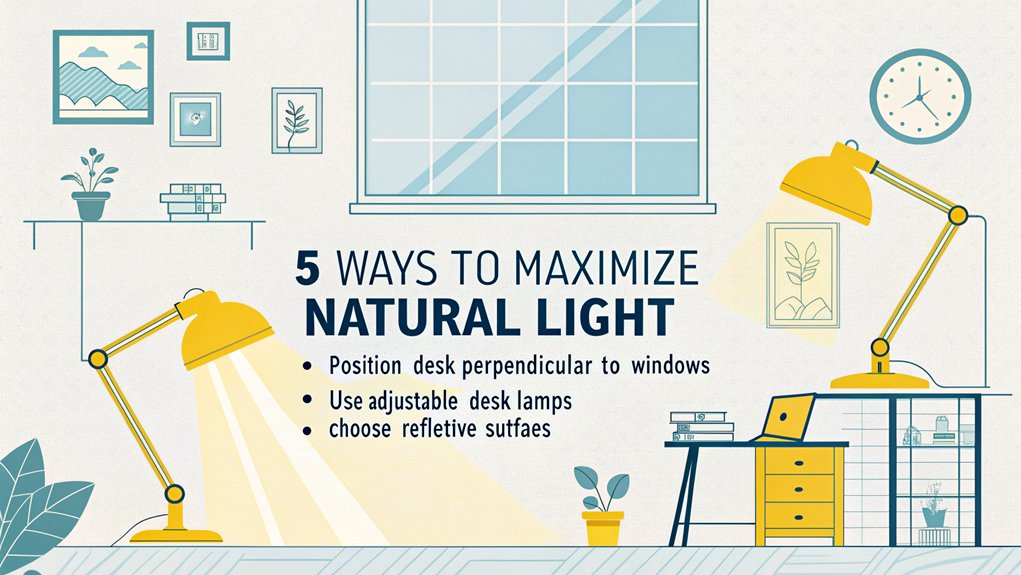
How can you harness the full potential of natural light in your workspace?
Start by enhancing your window orientation and workspace layout to create a climate where creativity flourishes.
Here are three strategies to maximize natural light:
- Unobstructed Windows: Keep large windows clear of furniture to allow sunlight to flood in, enhancing mood and productivity.
- Thoughtful Layout: Arrange workstations along the perimeter, ensuring that shared spaces are centrally located for ideal light distribution. This layout can enhance employee satisfaction as it maximizes exposure to natural light and can be complemented by implementing daylight controls in lighting fixtures.
- Reflective Elements: Incorporate light-colored surfaces and reflective materials, like mirrors and glass, to amplify the brightness in your environment.
These practical approaches can transform your workspace into a bright, airy haven, where innovation thrives.
Choosing the Right Type of Desk Lamp
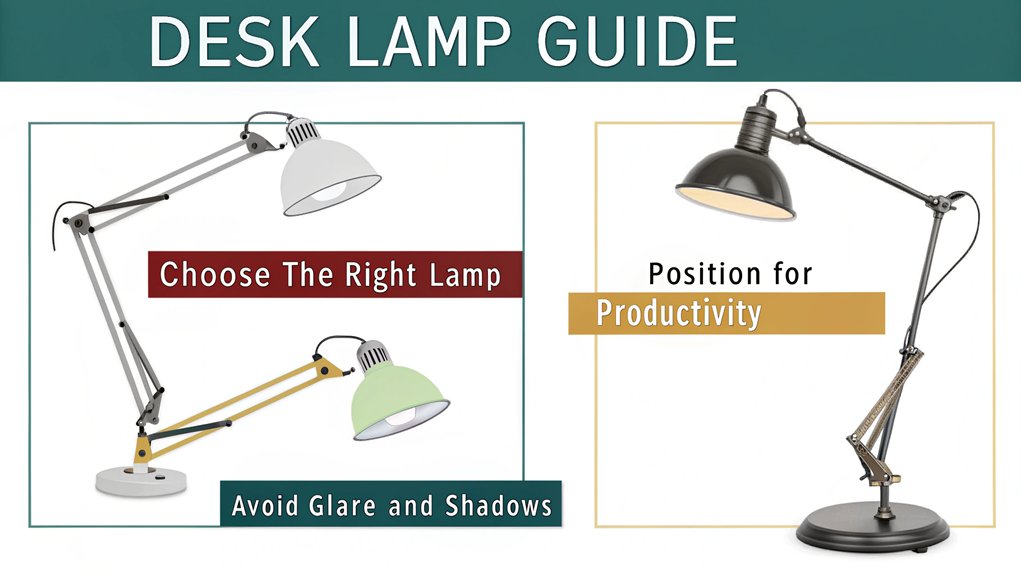
Selecting the right desk lamp can dramatically enhance your workspace, transforming it into a more functional and inviting area. Consider your needs and style preferences; here’s a guide to help you choose:
| Lamp Styles | Budget Options |
|---|---|
| Adjustable arms for targeted lighting | IKEA FORSÅ – great for under $30 |
| Compact designs for small spaces | Smart bulbs for enhanced functionality |
| Architectural styles for timeless appeal | High-end models with advanced features |
Opt for adjustable features if you need versatility, especially in task lighting. The NÄVLINGE LED work lamp is known for its built-in energy-efficient LED light source, which is essential for minimizing eye strain. Compact options are perfect for limited spaces. Remember, investing in energy-efficient lamps may save you money long-term, merging aesthetics with functionality effortlessly.
Optimal Placement Techniques for Different Tasks
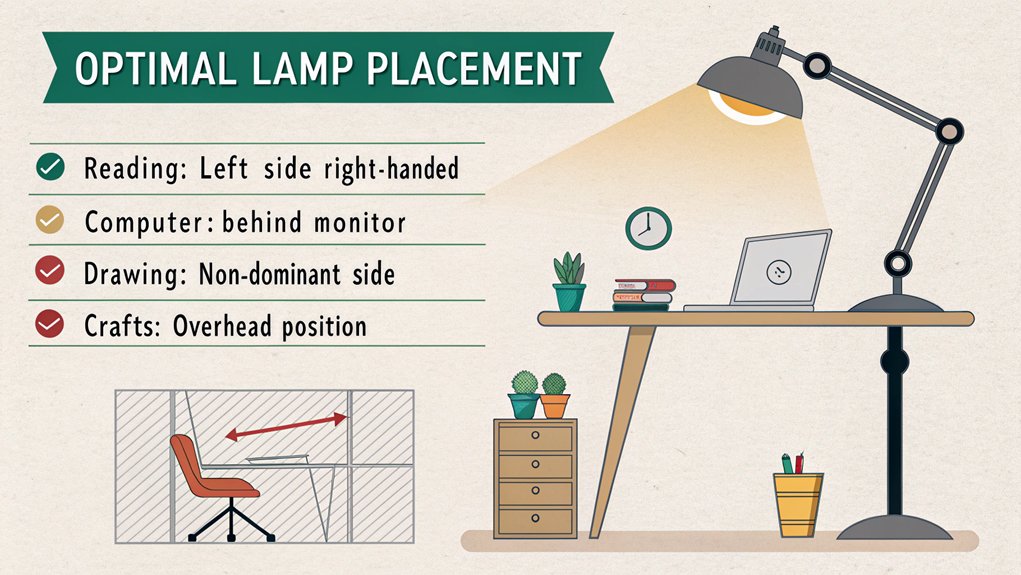
When you’re settling in for tasks like handwriting, reading, or using a computer, how you position a desk lamp can truly elevate your experience. Position your lamp to cast light where you need it most, reducing shadows and glare for ideal focus. Proper light placement is crucial for maximizing light source efficiency and ensuring a comfortable work environment. Additionally, task lighting is essential for providing adequate illumination tailored to different activities, especially for older individuals who might require more light.
Handwriting Task Lighting
Creating the perfect lighting setup for handwriting tasks can greatly enhance both your comfort and efficiency.
To optimize handwriting ergonomics, consider these essential lamp features:
- Adjustable Arms: Position a desk lamp’s arm to direct light precisely over your writing area, minimizing shadows.
- Dimmable Settings: Choose a lamp that lets you tweak brightness based on your needs, ensuring you’re never straining your eyes. Proper lighting design significantly affects your ability to maintain focus during handwriting tasks.
- Cool Color Temperature: Opt for cooler light tones to maintain focus and clarity while writing.
Computer Use Considerations
For ideal computer use, how you position a desk lamp is just as important as it is for handwriting tasks.
Position a desk lamp on the opposite side of your dominant hand, directing light towards your keyboard or mouse to guarantee task alignment. This strategy not only keeps your screen free from glare but also enhances visibility for your work.
Consider an adjustable or swing-arm lamp to accommodate multiple monitors, distributing light evenly without shadows. Keep the lamp slightly above eye level for best glare reduction.
Aim for a soft glow using warm white or yellow bulbs; it reduces eye strain while creating a cozy atmosphere.
Finally, maintain a distance of at least 15 inches between the light source and your workspace for maximum effectiveness.
Reading Position Strategies
How you position a desk lamp can transform your reading experience, making it both comfortable and efficient.
To optimize your reading posture techniques, consider these light direction tips:
- Adjustable Placement: Choose a lamp with an adjustable arm, positioning it to shine directly on your reading material without glare.
- Distance Matters: Maintain at least 15 inches between the lamp and what you’re reading, ensuring bright, inviting light while reducing eye strain. Proper lighting is key to enhancing your overall reading comfort and reducing fatigue. Additionally, providing cozy ambiance through layered lighting can create a more inviting and enjoyable reading space.
- Controlled Lighting: Utilize soft ambient light to enhance focus and complement available daylight, avoiding harsh shadows for a serene work environment.
Adjusting Light Intensity and Color for Productivity
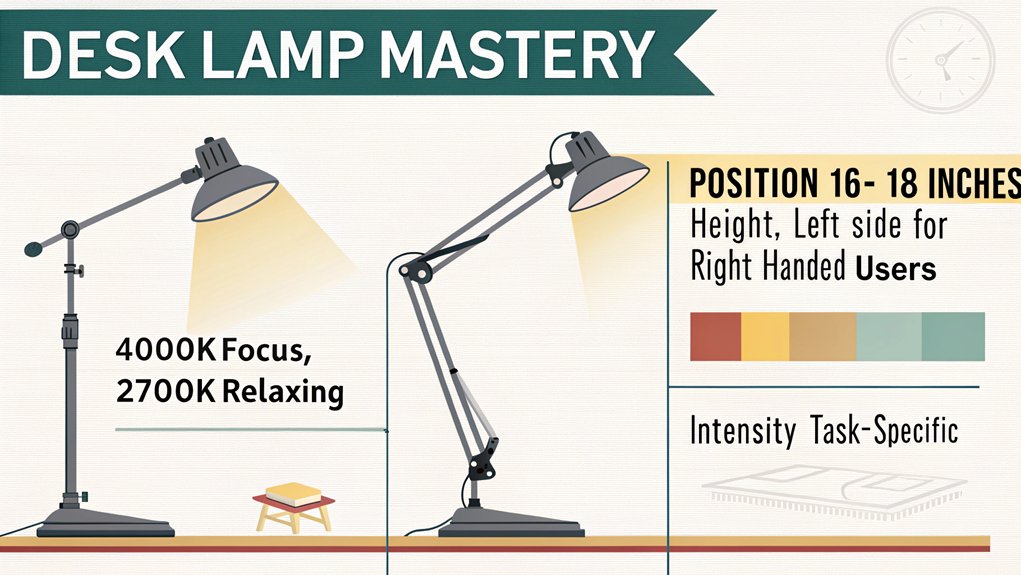
Adjusting light intensity and color can greatly enhance your productivity, especially in a workspace where focus is essential. Aim for a brightness of 450 to 750 lumens for general tasks, with 700 lumens preferred for reading and writing to reduce eye strain. Using LED lights with anti-flicker technology guarantees comfort during prolonged use. Experiment with the light spectrum; cool light (5000K-6500K) promotes concentration, while warm light aids relaxation. Additionally, good lighting can create a comfortable working environment that fosters creativity and efficiency. Ensuring your desk lamp is BIFMA Certified means it meets standards for durability and safety, contributing to a reliable workspace. Opt for adjustable lamps to seamlessly switch between warmth and coolness for effective task adaptation throughout your day. A Color Rendering Index (CRI) of 80 or higher ensures accurate colors, enhancing your overall lighting experience and allowing you to focus on what truly matters in your workspace.
Exploring Additional Lighting Options for Your Workspace
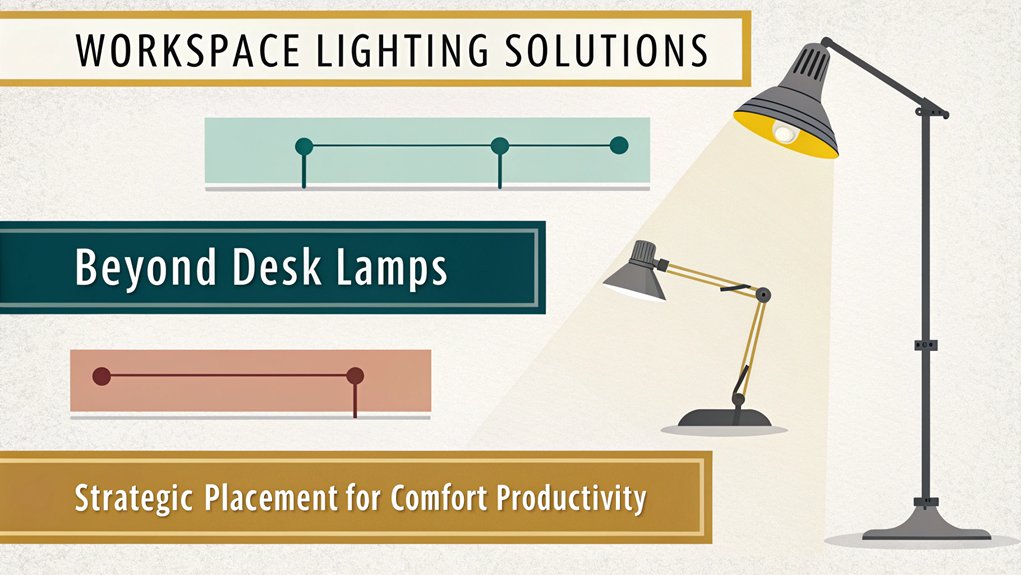
As you create your ideal workspace, pondering additional lighting options can greatly elevate both functionality and atmosphere.
Incorporating diverse sources of light not only enhances visual appeal but also boosts productivity. Here are three innovative options to ponder:
- Ambient Lighting: Utilize overhead fixtures or soft LED lights to create an inviting and uniformly lit environment that reduces eye strain. LED lighting is particularly effective for achieving high quality and energy efficiency in ambient settings.
- Accent Fixtures: Highlight artwork or architectural features with stylish sconces or table lamps, adding character to your workspace.
- Track Lighting: Install customizable track lighting to direct focused beams where you need them most, allowing flexibility and control over illumination.
Frequently Asked Questions
How Can I Reduce Glare From My Desk Lamp?
To reduce glare, you’ll want to implement glare reduction techniques like adjusting lamp positioning. Avoid direct eye line, use anti-glare bulbs, and position light to focus on your tasks, enhancing functionality while creating a pleasant ambiance.
What Height Should I Set My Desk Lamp?
In this digital age, adjust your lamp height between 14 to 24 inches for ideal brightness. This guarantees your workspace is well-lit, reducing glare while enhancing your productivity and making every task a breeze.
Can I Use Multiple Desk Lamps in One Workspace?
Absolutely, you can use multiple desk lamps in one workspace. Strategically arranging them enhances your lighting balance, while thoughtful lamp placement reduces glare and elevates your aesthetic, creating an innovative atmosphere that inspires productivity and comfort
How Often Should I Change Desk Lamp Bulbs?
Imagine your lamp as a wise old tree, thriving for 40,000 hours. With LED bulbs, you’re looking at nearly nine years of brilliance. Keep an eye on flickers, and adapt your bulb types accordingly.
What Are the Best Materials for Desk Lamp Shades?
When choosing materials for desk lamp shades, consider fabric shades for warmth, metal shades for sleekness, glass shades for elegance, and acrylic or paper shades for versatility. Ceramic shades deliver artistic flair while enhancing your workspace’s ambiance.
Conclusion
In the end, the right desk lamp placement can make all the difference in your workspace. By ensuring you keep it opposite your dominant hand and adjusted just right, you’ll not only banish shadows but also set the stage for productivity. Remember, good lighting is the key to revealing your potential. So, take a moment to find that sweet spot, and watch how this small change can bring your work to life!

I am a retired software engineer with experience in a multitude of areas including managing AWS and VMWare development environments. I bought a relative a mini-PC a year ago and have become passionate about the technology and its potential to change how we deploy software.

